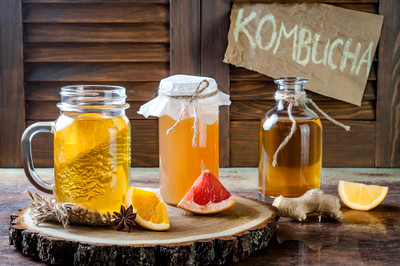All about Kombucha tea
Posted by The Wares Team on 6th Mar 2019
In today’s blog post, we’re going to leave behind the familiar jams, pickles and preserves that we often write about, to look at something a little more unusual; a fermented fizzy drink called kombucha tea. We’ll explain what fermentation is and what kombucha tea is, before going through the simple process for making your very own kombucha tea. As with many fermented foods, you can make further batches of kombucha tea using an existing batch, so once you’ve got started you can quickly become self-sufficient with it, providing a daily tonic for the whole family.
What is fermentation?
Fermentation, and fermented foods, are enjoying a surge in popularity at the moment. Many people swear by their health-boosting properties and an increasing awareness of the need for gut-friendly ‘good bacteria’ means that we are now more likely than ever to try foods and drinks that can help us maintain a healthy digestive system.
Fermentation is the process of using microorganisms, bacteria or yeasts to chemically transform carbohydrates into alcohol or organic acids. That all sounds terribly technical but the general principle is that fermenting food preserves it and also helps with the digestion of it. We all consume fermented foods without really noticing the fact, in the form of wine, cheese, bread, tea, and even chocolate. Both sauerkraut and kimchi are also good examples of fermented foods, as is surströmming, the rather horrid-smelling fermented herrings so loved in Sweden. Today, however, we are concentrating on kombucha, a tasty fermented drink that is said to have excellent health-related benefits.
What is kombucha tea?
Kombucha is a fizzy drink with a slightly sour taste which has sweetened tea as its base, along with something called a ‘scoby’, which acts as the trigger for the fermentation process. Scoby is actually an acronym, standing for ‘symbiotic culture (or colony) of bacteria and yeast’. If that all sounds a little alarming, there’s no need to worry. We think nothing of putting yeast in bread and most of us are aware that various cultures are added during the cheese-making process, in order to turn milk into the many different cheeses available to us. Think of these as types of scoby, if you like. To make kombucha, unless you start with a batch of kombucha given to you by someone else, you’ll need to buy a scoby starter pack. These are widely available to buy online and should not cost more than around £10-15.
How to make kombucha tea
To make your first batch of kombucha tea, you’ll need sugar, cold water, green or black tea and your kombucha scoby. Of course, you’ll also need a glass jar to put the kombucha in. A large mason jar is great for this, but whatever type of glass jar you use, it needs to have a wide mouth. A pickle jar or the largest size of mason jar would be ideal.
The first step for making a good kombucha is the most important and that’s sterilisation of your jars. If you don’t properly sterilise each glass jar that you use, you risk introducing bad bacteria as well as good bacteria. That could compromise the fermentation process and potentially make you ill.
To sterilise the jars you will be using, first wash the jars and lids in warm soapy water, allowing the jars to dry on the drainer and drying the lids with a clean tea towel. Place the jars in the oven, which has been pre-heated to 180°C. Leave the jars in the oven for 15 minutes and then remove them and allow them to cool.
Meanwhile, add the tea and sugar to boiled water, and allow it to cool. Then, pour it into your sterilised glass jar and add the scoby carefully, ensuring your hands are spotlessly clean. Cover the jar with cheesecloth or muslin, wrapped over to provide a double layer, holding it in place with string or an elastic band.
Place the covered jar on the counter, where it won’t be in the way, and leave for about a week, to ferment. Don’t place the jar in direct sunlight and ensure it remains at room temperature.
After a week, test the kombucha every day, until you reach the perfect blend of sweetness and tartness that you like.
When the kombucha is ready to transfer to a bottle, make up another batch of sugar and tea with water, so that you can transfer your scoby to the next batch. Carefully remove the scoby and place it on a clean plate, ready for the new batch. Also pour off a small amount of your finished kombucha tea, to use as a starter tea in that next batch.
Pour the rest of the fermented kombucha tea into sterilised bottles and add flavourings if required. You can flavour your kombucha by adding fruit, such as strawberries or elderberries, or herbs such as basil, ginger or chamomile. Store for 3 days, to allow the fizz to develop in your kombucha.

